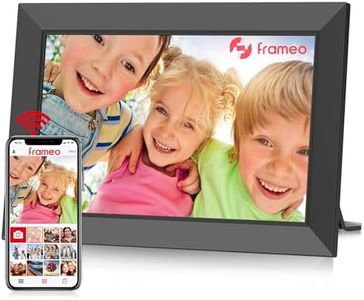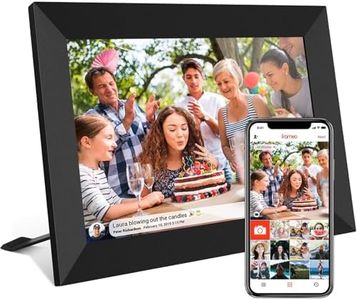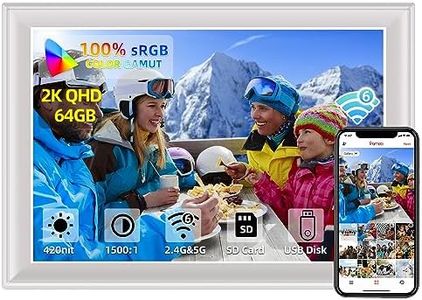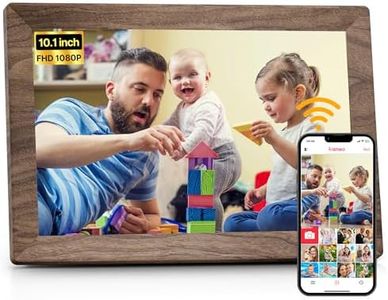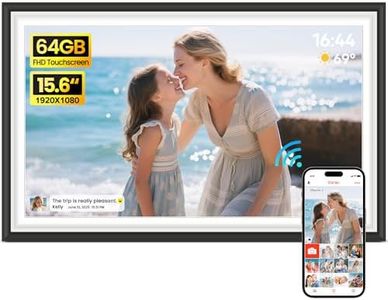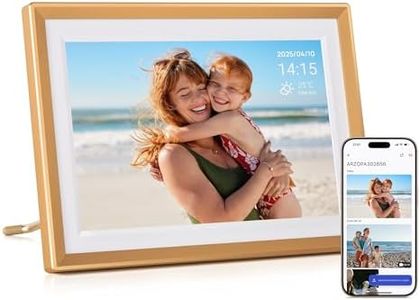We Use CookiesWe use cookies to enhance the security, performance,
functionality and for analytical and promotional activities. By continuing to browse this site you
are agreeing to our privacy policy
10 Best Digital Picture Frame
From leading brands and best sellers available on the web.By clicking on a link to a third party's website, log data is shared with that third party.
Buying Guide for the Best Digital Picture Frame
Choosing the best digital picture frame means thinking about where and how you'll use it, whether it’s for your home, office, or as a gift. A digital picture frame lets you display a slideshow of your favorite photos in a sleek, electronic format without needing to print them out. Great digital frames show pictures vividly and are easy to operate, making it important to focus on features that make them enjoyable and convenient for your needs. Understanding a few key specs can help you pick a frame that will look great and work perfectly in your setting.Screen SizeScreen size refers to the diagonal measurement of the display area, usually in inches. It's important because it determines how large your photos will appear and how much space the frame will take wherever you place it. Small screens (7-8 inches) are compact and fit nicely on desks or nightstands, making them ideal for personal spaces. Medium screens (9-12 inches) strike a balance between size and placement flexibility, suitable for shelves or countertops. Large screens (13 inches and above) are meant for larger rooms or if you want your pictures to be more noticeable, similar to a small television. To pick the right size, consider where the frame will go and how prominent you want your photos to be. If it’s for a small area close to where you sit, a smaller screen works well; for wall mounting or viewing from a distance, go larger.
ResolutionResolution measures how many pixels fit on the screen, often described as width by height (such as 1024 x 768). This affects picture clarity and sharpness: more pixels mean finer detail and better image quality. Low resolutions might make photos look blurry or pixelated, especially on larger screens, while higher resolutions (such as Full HD or 1280 x 800 and above) show details crisply. When shopping, look for a higher resolution if you want your images to look their best, particularly with bigger frames. If your frame is small and you mostly view it close up, a moderate resolution may still provide satisfying results. Think about whether image clarity or just convenience is most important for your use.
Storage and Photo Loading MethodsThis spec tells you how many and which ways you can get pictures onto the frame, such as built-in memory, SD card slots, USB ports, or even Wi-Fi/cloud connections. Traditional frames may use memory cards or USB drives, so you manually add and update photos. Others with Wi-Fi can connect to email, apps, or photo-sharing services, adding new images automatically. Built-in storage (measured in gigabytes) determines how many photos you can keep on the frame at once. Consider how tech-savvy you are and how often you want to change your pictures: if you prefer set-and-forget, Wi-Fi options are best, while those who enjoy curating specific images easily might appreciate memory cards or USB. Match the method to how you want to manage your pictures.
User Interface and ControlsThis refers to how you interact with the frame, adjust settings, and change photos. Some frames use basic buttons on the device, others have remotes, and advanced ones feature touchscreens or even app/phone controls. Simple interfaces are best for those who want a hassle-free experience and may not be comfortable with technology. Touchscreens and app controls offer more convenience and features but may take a little learning. To decide, think about who will use the frame: seniors or those who prefer straightforward controls may want physical buttons, while tech-savvy users will enjoy more innovative options.
ConnectivityConnectivity means how the frame communicates with other devices or the internet—this could be Wi-Fi, Bluetooth, or only physical slots. Frames with Wi-Fi let you update photos remotely, receive pictures from family, or even display weather or calendar info. Bluetooth can allow quick image transfers directly from your phone. If you want to keep your frame updated effortlessly or share pictures with others from afar, choose one with Wi-Fi. For more private or offline use, simple plug-in models do just fine. Pick connectivity based on how often you want to swap in new images and whether you'd like remote control features.
Aspect RatioAspect ratio describes the shape of the display, like whether it’s square (4:3), wide (16:9), or a bit taller (3:2). This matters because your photos will look best if the frame’s aspect ratio matches the images you take. Older cameras and phones often use 4:3, but many newer devices take pictures in 16:9 or 3:2. If the frame’s shape is too different from your photos, your images may appear with black bars or be cropped in odd ways. Consider the devices you use to take pictures and choose a frame with a matching aspect ratio for the best display.

